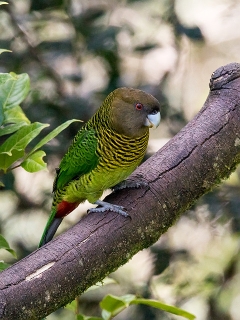Brehm’s Tiger Parrot |
|
|
Also known as: Brehm's Parrot, Brehm's Ground Parrot
Photos
View in GalleryDid You Know?
The Tiger parrots got their name because of their prominently barred plumage.Academic Research
Related publications: Psittacella brehmiiSpecies Profile
Genus: Psittacella | Species: brehmii
Size:
24cm (9.3 in)
Weight:
94-120g (3.3-4.2 oz)
Subspecies including nominate:
four: P.b. brehmii, P.b. intermixta, P.b. pallida, P.b. harterti
Colour Adult:
P.b. brehmii: Male-dark brown head, tinted olive; sides of neck have yellow line; green upperparts, with black barring; green breast; red undertail coverts; green tail. Bill blue/grey tipped with white. Eye red. Female-yellow line down sides of neck absent; yellow breast, with black barring.
P.b. intermixta: Both adults as in brehmii, but with more yellow underparts; paler olive/brown throat and sides of head. Larger in size.
P.b. pallida: Male-plumage is variable, but as in brehmii, and more yellowish upperparts and underparts; abdomen has blue suffusion on some birds. Female-differs from brehmii by having yellow flanks and sides of abdomen with black barring; more yellow upperparts and underparts.
P.b. harterti: Male-as in intermixta, but less yellow underparts; paler head with more olive colour. Smaller in size. Female-as in intermixta, but less yellow underparts; light black barring on flanks and sides of dull yellow abdomen. Smaller in size.
Colour Juvenile:
P.b. brehmii: As in adult female but with orange/red undertail coverts, the feathers tipped yellow/green. Eye yellow/brown.
Call:
Calls not often heard; when disturbed deep, short notes; also two-syllable harsh notes, some downslurred.
Listen NowVideo Links:
Video 1 | Video 2 | Video 3More Information:
Content Sources:
CITES
BirdLife International
Cornell Lab of Ornithology/Birds of the World
Parrots: A Guide to Parrots of the World, Juniper and Parr, 1998
xeno-canto Brehm's Tiger Parrot, Moore, John V., XC279385
Parrots of the World, Forshaw, 2006. 2010 edition
Lexicon of Parrots, Thomas Arndt.
Photos
View in GalleryDid You Know?
The Tiger parrots got their name because of their prominently barred plumage.Academic Research
Related publications: Psittacella brehmiiSpecies Care
Captive Status:
Virtually unknown in aviculture.
Longevity:
Not recorded.
Housing:
Aviary 2.5 x 1 x 2m (8.2 x 3.3 x 6.5 ft).
Diet:
Pine and grass seeds, different fruits and berries possibly may be tried. Also vitamin and mineral supplements.
Enrichment:
Not recorded.
Nest Box Size:
Not recorded.
Clutch Size:
Not recorded.
Incubation Time:
Not recorded.
Fledging Age:
Not recorded.
Hatch Weight:
Not recorded.
Peak Weight:
Not recorded.
Weaning Weight:
Not recorded.
Photos
View in GalleryDid You Know?
The Tiger parrots got their name because of their prominently barred plumage.Academic Research
Related publications: Psittacella brehmiiSpecies Wild Status
World Population:
Unknown, stable.
IUCN Red List Status:
Least Concern
CITES Listing:
Appendix II
Threat Summary:
Not globally threatened. Fairly common and widespread throughout range. Regularly recorded at Tari Gap, Papua New Guinea.
Range:
P.b. brehmii: Vogelkop Mountains, W Irian Jaya.
P.b. intermixta: Snow and Weyland Mountains and Mount Goliath, Irian Jaya.
P.b. pallida: Mountains of Papua New Guinea, excluding Huon Peninsula, and east from Sepik River area.
P.b. harterti: Mountains of Huon Peninsula, N Papua New Guinea.
Habitat:
Found from 1500-3000m (4920-9840 ft) in montane forest, including Podocarp and beech Nothofagus forest and forest edge.
Wild Diet:
Diet includes small seeds and berries from conifers and fruits of Podocarpus, buds, fruits and leaves of Homalanthus. Also lerps suspected, as often seen searching leaves.
Ecology and Behaviour:
Slow-moving, short distance fliers. Found singly or in small groups and are fairly tame. Feeds on or near the ground although they are found at higher levels as well.
Clutch and Egg Size:
Not recorded.
Breeding Season:
Nestlings have been recorded in May and June.
Related Links:
Photos
View in GalleryDid You Know?
The Tiger parrots got their name because of their prominently barred plumage.Academic Research
Related publications: Psittacella brehmiiMembers Only Resources
Please log-in now to find more research, resources and tools.
Not a Member?
Find more great information:
Gain exclusive access to 600+ pages of additional research, seminars and podcasts, specialists to ask your toughest questions, and dozens of other fun resources - when you become a WPT member.
Join Today >>

































